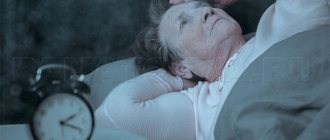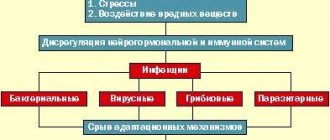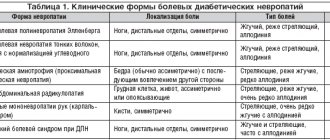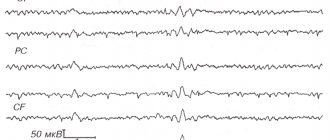Prognosis and prevention
The prognosis for the patient depends solely on the cause that triggered the onset of the disease. Acute and subacute ataxia caused by intoxication of the body, vascular disorders, and inflammatory processes can completely regress or partially persist. In this case, the prognosis for the patient will be as favorable as possible if the provoking factor can be eliminated in time: infection, toxic effects, vascular occlusion.
The chronic form of ataxia is characterized by a gradual increase in symptoms, which ultimately leads to disability of the patient. The greatest danger to the patient's life is cerebellar ataxia caused by tumor processes. The rapid development of the disease and disruption of the functioning of many organs leads to serious complications that significantly worsen the patient’s quality of life.
Prevention of cerebellar ataxia involves preventing traumatic brain injury, infection of the body, the development of vascular disorders, timely treatment of chronic cerebral ischemia, compensation for metabolic and endocrine disorders, and mandatory genetic counseling during pregnancy planning.
Among all acute cerebrovascular accidents, cerebellar infarctions are a relatively rare pathology, accounting for 1.5 to 2.3%. Cerebellar infarctions account for 5.7% of all ischemic strokes, but their mortality rate exceeds 20%. Cerebellar hemorrhagic stroke accounts for 4.8–10% of all hemorrhagic strokes, with a mortality rate ranging from 20 to 75%. The incidence of cerebellar infarctions is slightly higher during autopsies, since about half of the “old” cerebellar strokes are asymptomatic and detected only at autopsy, accounting for 1.5 to 4.2% of the total number of autopsies [1–6].
With the introduction of neuroimaging methods into clinical practice, new types of cerebellar infarctions have been identified. Among them: watershed infarctions, or borderline infarctions; small (lacunar) infarctions; infarctions in the basin of the superior cerebellar artery, usually combined with infarctions of the brainstem (with thrombosis of the basilar artery). The topographic classification of cerebellar infarctions is given in the table [5, 7].
The age of patients with cerebellar infarction is on average about 60 years (from 18 to 80 years). Men are 2–2.5 times more likely than women to suffer from ischemic stroke, but the prevalence of hemorrhagic strokes is the same among men and women [2, 8].
For many years, the cerebellum has been considered a key brain structure in regulating motor functions. Thanks to the research results of the school of academician L.A. Orbeli and modern data have established that the cerebellum takes part in the implementation of other functions of the body (psycho-emotional, vegetative, etc.). In recent years, experimental studies have been carried out regarding the role of the cerebellum in the implementation of cognitive functions [9–11]. It has been established that the earlier in ontogenesis damage to the cerebellum occurs, the more severe are the clinical manifestations of disorders of the motor, speech, psycho-emotional and cognitive spheres [12].
The spectrum of behavioral and cognitive impairment (CI) resulting from cerebellar stroke is defined as cerebellar cognitive affective syndrome. This syndrome involves impairment of executive functions and is characterized by perseverations, distraction or inattention, visuospatial disturbances, difficulties in speech production, and personality changes. At the same time, remote episodic and semantic memory is preserved, and the ability to learn new things is affected only to a small extent [13, 14].
Cognitive-affective disorders with damage to the cerebellum are caused by damage to neurons and neuronal pathways at different levels: cortical-pontine-cerebellar and olivo-pontine-cerebellar [10]; specific and nonspecific cerebellar-thalamo-cortical systems with the inclusion of associative cortical zones [15]; cerebellar-reticular, cerebellar-hypothalamic and cerebellar-limbic systems [16]. A close connection has been proven between psychoemotional manifestations and the functional state of the cerebellar vermis [17]. Cognitive-affective autistic disorders caused by damage to the dentate-thalamo-cortical pathways and other cerebellar-cerebral connections (limbic system, frontal cortex, temporal lobes, etc.) have been described [18]. Speech function disorders have been studied more deeply: it becomes slow (bradylalia), scanned, handwriting changes - micrography [19, 20]. According to B. Murdoch and B. Whelan, both hemispheres of the cerebellum are involved in speech processes. In 2001, P. Marien et al. put forward the concept of a “lateralized linguistic cerebellum.” Speech disorders with cerebellar lesions are characterized by impaired speech motor skills (dysarthria); disturbance of the dynamics of speech (on the one hand, scanned speech, on the other - a violation of initiation and impoverishment of speech up to the development of mutism); disorders defined as aphasic (“cerebellar-induced aphasia”) are accompanied by agrammatism, sometimes defects in the structural and syntactic construction of sentences, difficulties in naming and finding words, and difficulties in reading and writing [18].
In many patients with cerebellar stroke, clinical symptoms go beyond the above-described symptom complex. Thus, some patients develop hemiparesis or hemihypesthesia, and cognitive functions are impaired. This symptomatology in isolated lesions of the cerebellum is explained by damage to the fronto-pontocerebellar and occipitotemporal-pontocerebellar tracts [21–23].
The cerebellum was initially underestimated in its influence on the cognitive sphere. The concept of the influence of the cerebellum on cognitive processes was formed relatively recently, but already in 1997 in the USA, under the editorship of JD Schahmann, the world’s first monograph “Cerebellum and Cognition” was published, summarizing the currently available clinical, anatomical, physiological and neuroimaging data [14 ]. The anatomical basis for the participation of the cerebellum in mental functions is its bilateral connections with the associative zones of the cortex of the predominantly contralateral cerebral hemispheres and the limbicoreticular complex. At the same time, the isolated existence of pathways going to the motor cortex and prefrontal parts of the brain was noted, which in turn determines the possibility of isolated occurrence of cognitive and motor disorders with damage to the cerebellum [14, 24–30]. It has also been shown that cerebellar pathology of various origins (tumors, degenerations, hypoplasia, vascular changes) leads to a wide range of disorders of mental functions [27, 31–36]. Behavioral changes associated with cerebellar damage are characterized by a change in personality with a dulling of the emotional sphere; disinhibition of behavior or inappropriate behavior; impairment of many executive functions, including planning, ability to change settings, difficulties with abstract thinking; decreased speech fluency and impaired working memory; problems with spatial cognition, including visual-spatial organization and memory; speech disorders, including agrammatism, dysprosody and some anomia.
Numerous neuroimaging studies in recent decades have demonstrated that cerebellar activation occurs during cognitive and language tasks. According to dynamic MRI (magnetic resonance imaging), the cerebellum is activated when performing cognitive tasks (contralateral to the activated cortical area), while transforming the flows of information coming to it, transmitting impulses to the necessary neurosensory areas [29].
When repeating motor, cognitive, and language tasks, the cerebellum and cerebral cortex “learn” to perform these tasks automatically, increasing the speed of execution. JD Schmahmann, JC Sherman identified a “cerebellar cognitive-affective syndrome” consisting of executive function disorders, spatial reasoning disorders, language deficits and personality changes. This syndrome is associated with disruption of the neuronal circulation connecting the prefrontal, posterior parietal, temporal and limbic cortices.
The practitioner must be knowledgeable regarding the cognitive, emotional and behavioral aspects of post-stroke cerebellar disorders for proper assessment, timely treatment and successful rehabilitation of such patients. Moreover, the possibility of cerebellar involvement should be considered in patients with acute behavioral changes. The use of the cerebellum as a reference region (region for comparison) in functional neuroimaging studies may need to be reconsidered, especially for patients with CI. Just as the cerebellum supports balance, integration and stability in the motor domain, it can contribute to the balance, integration and stabilization of higher mental functions of the brain [37, 38].
According to the results of a study of patients diagnosed with cerebellar infarction, conducted at the Research Institute of Neurology of the Russian Academy of Medical Sciences, the most typical complaints of patients include difficulties concentrating, asthenia, difficulties in performing several actions at the same time, and becoming familiar with new information. Some patients note a deterioration in numeracy and writing skills [21]. According to the results of the study, the symptom complex of post-stroke cerebellar CIs can be divided into three groups. The first group of symptoms includes disturbances in attention, counting, dynamic components of speech, dynamic praxis, the volume of current memorization and memory for past knowledge. The study revealed the involvement of the cerebellum in the performance of all types of tasks where it is necessary to “unfold” operations in time and sequence to synchronize any action. The second set of damage to higher mental functions may include difficulties in activating visual ideas, carrying out optical-spatial activity and spatial praxis. The third complex is associated with violations of programming and control, where control deficits are represented by patients’ mistakes such as contaminations and confabulations when updating memory traces and programming violations at all stages of the implementation of a mental act.
With the introduction into clinical practice of such neuroimaging methods as positron emission tomography (PET) and single photon emission tomography (SPET), it became possible to assess the state of cerebral metabolism and blood flow during cerebral infarction. It is known that in cases of cerebral circulation disorders, PET and SPET reveal a focus of hypometabolism and hypoperfusion, corresponding to structural changes on computed tomography (CT) or MRI. In addition, distant changes in cerebral blood flow and metabolism are often detected, which are explained by the suppression of synaptic activity in topographically distant, but synaptically connected areas of the brain [39, 40]. In cerebellar infarctions, the most studied of these distant changes is crossed cerebellar diaschisis during stroke in the cerebral hemisphere. In this case, a decrease in metabolism and perfusion occurs not only in the stroke focus, but also in the contralateral cerebellar hemisphere [40–42].
These distant foci of hypometabolism may contribute to clinical symptoms and influence the outcome of cerebellar stroke [43–45].
Patients with cerebellar dysfunction, along with cognitive disorders, may have depressive and other forms of mental disorders, limitations in cognitive ability and flexibility, slowed reactions and impaired voice timbre, concentration, as well as a decrease in the ability to automatically perform “multi-tasking problems”. These important aspects of behavior affect the quality of life of patients, their employment and personal relationships.
Recognition that the cerebellum is not only the center of motor functions, but also an important component in the formation of personality and intelligence, requires the development of new strategies for the rehabilitation of patients with post-stroke cerebellar disorders.
The principles of drug treatment of CI in cerebellar stroke are the same as in the treatment of the consequences of impaired cerebral blood supply of any location.
A significant problem is that for most drugs used in domestic clinical practice, there is no data from placebo-controlled studies that would convincingly confirm their effectiveness. At the same time, a number of controlled studies have shown a clinically significant effect of drugs used in the treatment of post-stroke CIs.
Etiotropic and pathogenetic therapy of post-stroke CI is primarily aimed at the underlying pathological processes of cerebrovascular insufficiency, such as arterial hypertension, atherosclerosis, heart disease, etc. An important pathogenetic measure is also the impact on other known risk factors for cerebral ischemia, such as smoking, diabetes mellitus, obesity, physical inactivity.
To improve cognitive functions, a wide range of nootropic drugs are used, which can be divided into main groups: drugs with a neurometabolic effect, drugs with a neurotrophic effect, drugs acting on certain neurotransmitter systems, drugs with a vasoactive effect.
The goal of neurometabolic therapy is to increase the compensatory capabilities of the brain associated with the phenomenon of neuroplasticity. The use of peptidergic and amino acid drugs is due to their effect on cerebral metabolism. The use of acetylcholinergic and glutamatergic drugs is based on data on the presence of acetylcholinergic deficiency in vascular dementia and the role of this neurotransmitter deficiency in the formation of CI. With the use of these drugs, regression of both cognitive and other neuropsychiatric disorders is observed. The choice of strategy for influencing cerebral neurotransmitter systems in CI is determined by the stage of the process. In the treatment of dementia, acetylcholinesterase inhibitors (donepezil, rivastigmine, galantamine, ipidacrine) and reversible NMDA receptor blockers (memantine) are used. At the stage of pre-dementia (mild and moderate) CI, priority is given to drugs with the synaptoregulatory effect of choline alfoscerate, neuropeptides and their analogues, racetams. It is also advisable to influence other neurotransmitter systems, primarily dopaminergic and noradrenergic (piribedil).
The use of vasoactive drugs is associated with the regulation of vascular mechanisms underlying cerebrovascular accidents. Endothelial dysfunction, which impairs the functioning of the neurovascular unit, can be considered one of the most promising targets for therapeutic intervention in microvascular pathology [46]. To date, experiments have shown that statins, angiotensin-converting enzyme inhibitors, angiotensin receptor blockers, and some cholinomimetics can increase the reactivity of small vessels and improve brain perfusion, but whether this effect has clinical significance remains unclear. Antioxidants that block the action of free radicals generated due to ischemia may also potentially increase functional hyperemia by promoting neuronal-vascular coupling [46].
Symptomatic therapy is important in the supervision of patients with cerebellar post-stroke CIs. It is important to screen for depression and anxiety disorders and prescribe appropriate treatment if identified. If dizziness occurs, you should use drugs that act on histamine H1 and H3 receptors, reduce the severity of vestibular disorders and improve microcirculation in the vessels of the inner ear.
Drug and surgical treatment
Treatment of patients with cerebellar stroke includes effects on cerebral vessels and neurons, basic therapy. In particular, the effect on cerebral vessels implies recanalization (thrombolysis, mechanical thrombectomy, acetylsalicylic acid) and prevention of thrombus formation, while the effect on neurons implies neuroprotection and stimulation of neuronal plasticity. Basic therapy consists of correcting breathing disorders, regulating the functions of the cardiovascular system, controlling glucose metabolism and body temperature, normalizing water-electrolyte balance, preventing and treating complications.
Unsuccessful conservative measures require the use of more radical methods of treatment, for example, to remove a blood clot when it is detected or to remove blood clots, reducing intracranial pressure.
Treatment of cerebellar ataxia
Treatment methods for ataxia and their effectiveness depend on the underlying cause that caused the condition. Treatment of motor coordination disorders due to brain damage in older people can reduce the manifestation of ataxia, but not completely eliminate it. The results of therapy are more noticeable in patients with one focal lesion (for example, stroke or benign tumor). In people with degenerative diseases of the central nervous system, therapy is less effective.
Treatment of cerebellar ataxia is complex - taking pharmacological medications and regularly performing special exercises.
To improve the condition of patients diagnosed with impaired coordination of movements, the following is prescribed:
- 5-hydroxytryptophan (5-HTP);
- idebenone;
- amantadine;
- physostigmine;
- L-carnitine;
- trimethoprim/sulfamethoxazole;
- vigabatrin;
- phosphatidylcholine;
- acetazolamide;
- 4-aminopyridine;
- buspirone;
- combination of coenzyme Q10 and vitamin E.
Physical rehabilitation helps adapt activity and facilitate motor learning. For cerebellar ataxia, Frenkel exercises, proprioceptive neuromuscular facilitation (PNF), and balance training are indicated.










